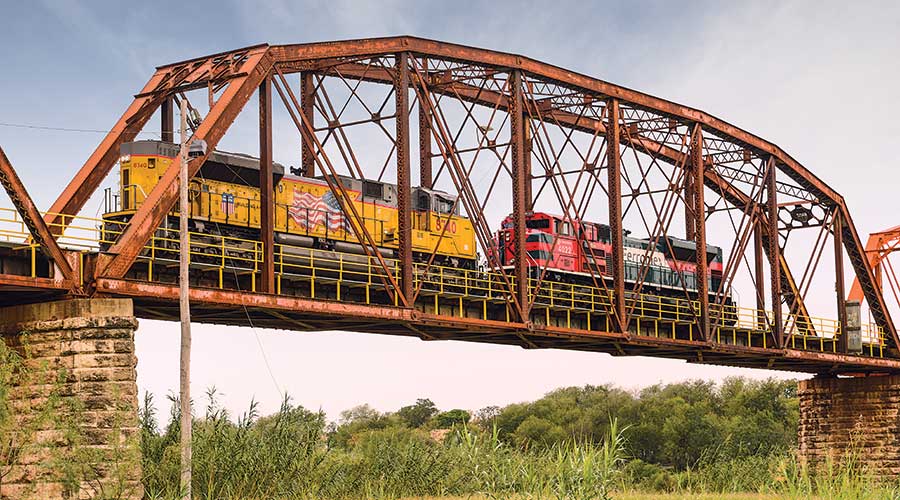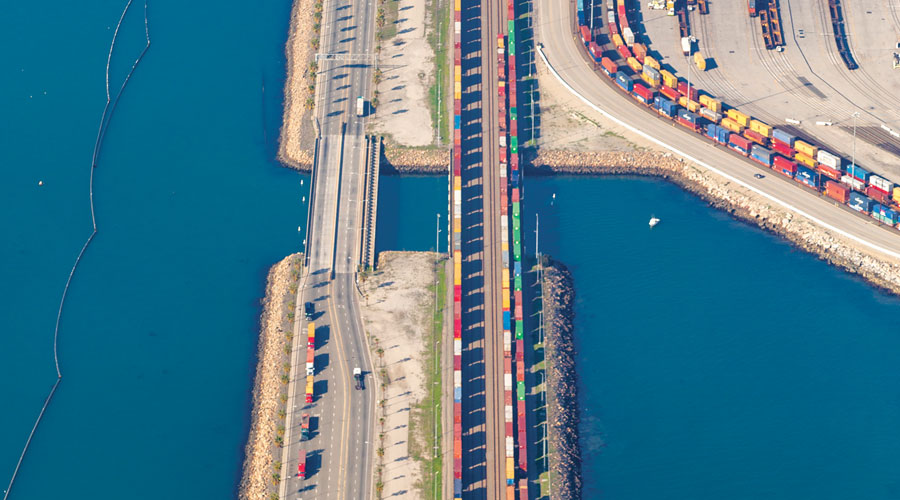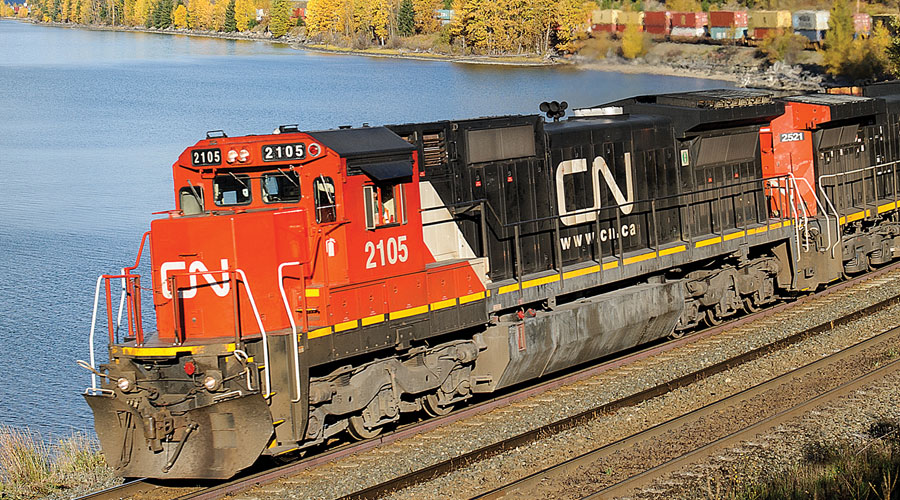Stay updated on news, articles and information for the rail industry
September 2013
Rail News: CSX Transportation
UPS relies heavily on railroads to keep the giant Chicago Area Consolidation Hub on schedule
— by Jeff Stagl, Managing Editor
The world's largest ground package sorting facility doesn't seem all that imposing from the road leading into the suburban Chicago complex. Known as the Chicago Area Consolidation Hub (CACH), the mostly one-story United Parcel Service (UPS) facility appears to resemble a conventional distribution center or warehouse.
But a bird's-eye view of the 240-acre complex from the hub's employment office on a nearby hill reveals a gargantuan central building and 10 long and narrow "spokes" that house a seemingly endless row of overhead doors. Overall, the complex — which opened in 1995 and is large enough to be located in both Hodgkins and Willow Springs, Ill. — totals 1.5 million square feet.
Some facts about the CACH (pronounced "catch") are just as impressive as its size:
- 1,300 docks for loading and unloading trailers and containers;
- 80 acres of paved areas with staging space for more than 4,000 trailers;
- a dizzying array of conveyor belts and rollers that would stretch 65 miles if laid end to end;
- a NASA-like control room that manages 80,000 separate systems to control the flow of packages, each of which needs only about 10 minutes to travel from an inbound door to an outbound door via mostly automated handling equipment; and
- a staff of 5,700 employees and 100 mechanics.
On a typical day, the hub sorts, consolidates and distributes 1.3 million to 1.5 million packages. During the peak season — from late September through the holidays — the CACH processes 2.5 million to 2.7 million packages daily and employs as many as 6,300 people.
Ten percent of UPS' entire volume nationwide is handled at the hub, which processes packages that are sent to more than 90 percent of the company's 1,160 domestic facilities and touch every U.S. address. It's an understatement to say the CACH is a vital facility for the world's largest package delivery company, which processes 16.3 million parcels each day using more than 96,000 vehicles, and employs 323,000 people in the United States and 76,000 overseas.
It's also no exaggeration to say the hub's managers have their hands full ensuring the enormous facility can handle an overwhelming volume of incoming and outgoing packages in a fashion that meets each parcel's time-sensitive transit requirement. To help ensure packages arrive at CACH and are delivered on time, the managers rely heavily on rail.
Half of the hub's incoming and outgoing volume is moved by rail, with the other half transported by trucks. In the Chicago area, UPS relies on BNSF Railway Co., CN, CSX Transportation, Norfolk Southern Railway and Union Pacific Railroad to accommodate its transportation needs, while some long-distance traffic is assisted in other areas by connecting carriers Kansas City Southern and Florida East Coast Railway. Typically, UPS uses rail if a shipment is traveling 400 or more miles.
"Rail is a 24/7 operation for us. We depend on our transportation partners," says Keith Hargarten, CACH's dispatch manager/feeder, adding that the hub requires 92 trains per day, and moves 5,000 inbound and 6,000 outbound shipments by rail per week at 13 intermodal ramps.
Ballet Enthusiasts
The coordination, communication and collaboration required between UPS and the railroads to meet CACH's stringent rail needs is akin to a ballet, says Ken Buenker, vice president of UPS' corporate transportation services, who is responsible for rail transport company-wide.
Inbound loads need to arrive at the hub in time to meet the beginning of a four-hour day, twilight or nighttime sort, while outbound volumes have to get to a yard, be loaded quickly on a train, depart as scheduled and travel in an expedited fashion to their destination.
"Time is an opportunity to do what we promised we would do for customers," says Buenker. "We hold the railroads to high standards."
Sorts are planned based on agreed-upon railroad availability, a measure that ignores a train's arrival time and primarily determines if UPS is provided the opportunity to bring loads to destinations for timely sorting within the company's integrated network, says Buenker. Each railroad's goal is 95 percent availability.
"When a train misses availability, it can cause chaos in the sortation process with the distribution of packages not lining up with the operating plan for the facility," says Buenker. "A typical sort will have three or four full lines of trailers and containers to unload. If the rail loads are planned on the first unload line, when they are not available we have to either move something else into that sortation position or push the volume to a later slot, which causes a multitude of issues due to an imbalance in the operating plan."
Typically, UPS tries to plan a smoothed-out, four-hour flow to a sort, especially at the CACH. However, when there are kinks in available loads to process, packages might flow poorly in the first hour, and then have to either flow to an area not designed for them or hold up the network so the hub can process the work later — "scenarios that aren't ideal for us to ensure we live up to our promise to our customers," says Buenker.
The past four decades have been a period of constant adjustment with railroads to create schedules and premium services that best serve UPS' needs, especially in Chicago, he says.
"The premium schedules developed by railroads are ours," says Buenker, adding that the railroads essentially designed their networks "around us."
One Versus Thousands
UPS is generally satisfied with railroads' availability in and around the Windy City, he says. But there's always room for improvement. If a train is late, a railroad only disappoints one of its customers — UPS — while the parcel company literally disappoints thousands of customers, says Buenker.
To help boost rail efficiency and limit disappointments, UPS over the past several years has emphasized a transition to more containers instead of trailers on all North American railroads because containers can be more efficiently double stacked. The company purchased 5,000 53-foot containers in 2011 and 2012 to increase its container usage, says Hargarten.
UPS uses a mix of its own containers, railroad assets and some trailer-on-flat-car equipment due to network configurations or physical requirements of origin/destination facilities, says Buenker.
"Many of the railroads have their own assets, so we utilize their equipment, and then they have other customers who will use the same piece of equipment coming out of a market that we went into," he says.
UPS has tried to become more aggressive with moving containers on double-stack trains for many of the same reasons railroads are creating more double-stack lanes: less highway congestion, better velocity, fewer emissions and reduced gas usage, says Buenker.
"A double-stack train in essence replaces the need for another train," he says.
The BNSF Connection
BNSF's Willow Springs yard, which is adjacent to the CACH, has tried to keep up with UPS' transition to containers and double-stack trains. Prior to 2011, all the yard's UPS cargo moved in trailers; now, about 40 percent of the yard's 500,000 annual lifts involve UPS freight. The parcel company is the facility's top customer as measured by total annual lifts, which last year exceeded 196,000.
"UPS represents approximately 20 percent of our trailer-on-flat-car business after their conversion to containers," says Gregg Zody, BNSF's director of UPS marketing-consumer products. "Prior to containerization, they were approximately 42 percent of our trailer business."
Overall, trailers on flat cars represent 80 percent of the terminal's operations, with containers on flat cars accounting for the remainder.
Trucks need less than two minutes to travel from the CACH to BNSF's facility via a private connecting roadway. The 186-acre terminal features nine tracks, eight overhead cranes and double concrete ramps so trains can be loaded or unloaded from either side. The yard handles about 1,400 UPS loads per day, and averages 12 outbound and 11 inbound trains daily.
"If a train is available, we come and get it — there's no dwell time," says Buenker.
The yard currently averages 96 percent availability for UPS. Next year, BNSF plans to add 300 parking spaces at the yard to further boost service capacity.
Yard managers work very closely with the UPS team on a daily basis to ensure service is planned and executed according to the CACH's needs and expectations, says Zody.
"For years, we have appreciated their trust in allowing us to be a part of their transportation solutions," he says.
The disciplined service BNSF tries to provide UPS in Willow Springs recently helped the Class I land business for perishables — such as shredded lettuce — that needs to be transported in refrigerated cars and in an expedited fashion, says Zody.
The CSX 'Touch'
UPS' business also is nurtured at CSX's Bedford Park intermodal terminal, which is located about seven miles from the CACH. UPS' former Chicago-area consolidation facility is adjacent to the terminal; in 1995, the complex — which is about one-quarter CACH's size — became a sorting hub for local parcels.
About 52 percent of CSX's entire UPS business is "touched" at the Bedford Park terminal, which features 10 processing and 12 storage tracks, says Terminal Manager Matthew Hiller. The largest intermodal facility in CSX's network, the 300-acre Bedford Park terminal registered 1.05 million lifts in 2012. The 24/7 facility, which opened in 1984 as CSX's primary Chicago terminal, retains storage capacity for 6,000 53-foot wheeled containers and 5,000 stacked containers.
The terminal's average availability for UPS is 98 percent while the core average in CSX's network is 91 percent, says Terminal Superintendent Doug Daun. To bolster service performance for the parcel company, terminal managers try to keep chassis supply in balance and stay in constant contact with CACH executives, as well as officials at other railroads, he says.
"We communicate with BNSF and try to help each other recover, if necessary," says Daun. "We reach out if there's a service disruption."
CSX also provides UPS the sole use of an expedited gate at the terminal and a special area for storing its equipment. In addition, the facility has assigned a coordinator who's tasked with managing and troubleshooting all UPS traffic at the terminal.
Go With The Flow
To help UPS, as well as all terminal customers, CSX tries to keep traffic flowing at the facility, in part by employing an automated gate system (AGS) that helps trucks enter and depart the facility more quickly.
The system verifies driver information (using thumbprint and optical character recognition software), prevents unauthorized access and alerts terminal staff to unsafe equipment conditions by generating digital images of equipment as it arrives at the facility. The AGS gate features 13 inbound and nine outbound lanes, and the terminal averages more than 4,000 gate moves daily.
Consistent and reliable traffic flow is vital to the CACH since the hub is designed to handle 3.1 million packages daily — a figure that might not take the facility all that long to reach. When the hub opened on March 31, 1995, it handled 200,000 packages per day, a volume that since has increased about eightfold.
UPS' collaborative relationship with railroads — which Buenker characterizes as a partnership — will help the company reach its growth goals, as well as better participate in global commerce, he says. After all, both UPS and railroads have the same ultimate goals, says Buenker.
"Faster, quicker and smarter is important to both of us," he says. "It's all about connectivity. We're all in this effort together to make it work."


 LRW Honors Amtrak’s Acheson As Railway Woman Of The Year
LRW Honors Amtrak’s Acheson As Railway Woman Of The Year
 From Editor-In-Chief Foran: Of Gender Equity And Inclusion
From Editor-In-Chief Foran: Of Gender Equity And Inclusion
 Spotlight On Some Of Today’s Rail Safety Products
Spotlight On Some Of Today’s Rail Safety Products
 Women of Influence in Rail eBook
Women of Influence in Rail eBook
 railPrime
railPrime







